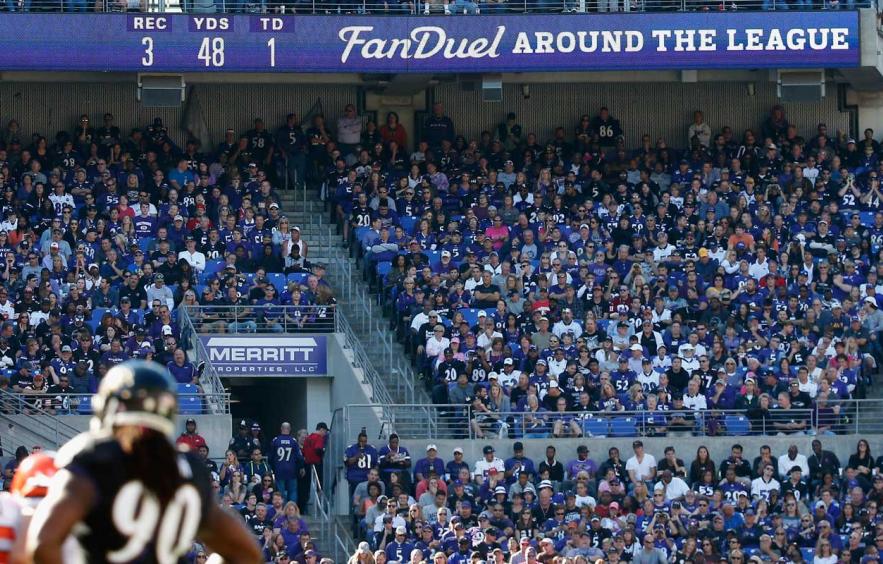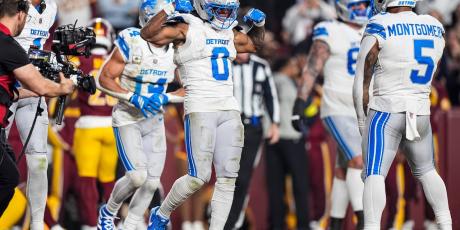10 Tips for New NFL DFS Players

The goal of this article is to provide a list of objectives for you to meet while you complete your daily fantasy football process each week. Whether you’re a seasoned vet or just getting your feet wet in the daily fantasy realm, these tips for improving your return on investment ring true for all experience levels. I’ve been reflecting on and revising the way I attack daily fantasy football since I first began playing seven seasons ago. The following advice is broken down into three categories: bankroll management, game selection, and lineup construction.
Bankroll Management
1. Use Historical Data to Determine Which Contest(s) You Win Most Often
Blindly firing money into random contests is a surefire way to go broke in a hurry. You may have an inclination as to which contests your win rate is highest, but it’s best to make sure. There are several sites around the net that allow you to upload a CSV file of your contest data. Once uploaded, you will be able to see the break down from many different angles. The contest data highlights your win rates in contests of different sizes, dollar amounts, entry maxes, and game types. Personally, I’m a much better double-up and 50/50 player than I am a GPP or head-to-head player. Therefore, I make sure the vast majority of my bankroll for the week lands in double-ups and 50/50s. If you’re relatively new to DFS, the sample size may not be large enough to get a true gage of your strengths and weaknesses. Make sure to keep an eye on your performance throughout the year. Overall, viewing your historical contest data can be a revelation to players, especially if you have a glaring strength.
On DraftKings you can download your contest history CSV by clicking Contest > History > Download Entry History
On FanDuel you can download you contest history CSV by clicking History > Download CSV
2. Determine Bankroll Allocation Based on Historical Contest Data
The next order of business is to figure out what percentage of your total bankroll should be in play on a weekly basis. The amount you can afford to lose for the entire season should be considered your bankroll. Some mistake bankroll for the exact amount that sits in your account on daily fantasy sites. However, if you’re willing to deposit more money throughout the year, then all of the deposits added together technically makes up your total bankroll.
My advice would be to set an exact amount that you want to dedicate to daily fantasy football before the season starts. You don’t have to deposit it all Week 1, but have an amount that you are willing to lose during the course of the year. For instance, If you initially deposit $500, but are willing to make two more deposits of $250 if your initial deposit dries up, your total bankroll for the season adds up to $1,000. You would calculate all weekly percentages from that $1,000, no matter the amount currently in your account.
The percentage of bankroll wagered weekly should correspond to the types of games you are playing, which should, in turn, correspond to the types of games in which you are successful at winning. If your historical data dictates that have a greater return on investment in GPP contests, you can ratchet up the ratio of tournaments to cash games you play. If this is the case, you would lower the percentage of total bankroll in play due to GPPs being volatile. Conversely, if your cash game return on investment is greater, you would invest a large portion of your bankroll in double-ups, 50/50s, and head-to-head contests. Your percentage of cash games entered should positively correlate with bankroll percentage wagered, meaning the more cash games entered the more of your bankroll you can wager, to a point. Make sure you are also entering contests according to dollar amount and entry size/limit if your contest data dictates a preference. Below is a sample (not steadfast) chart for you to visualize bankroll allotment.
| % of Total Bankroll In Play | % in Cash Games | % in GPPs | Risk Tolerance |
|---|---|---|---|
| 10–12 | 90 | 10 | Low |
| 7–9 | 75 | 25 | Medium |
| 4–6 | 60 | 40 | High |
If you’re a casual player that’s just looking for a few lottery tickets of entertainment every week, by all means, go all in on GPP contests, the above graphic pertains to players looking to grind out a profit while waiting on a big cash. The table should serve as a guideline, however, I’d cap my percentage of bankroll in play at 20 percent at the most.
3. Remaining Disciplined is the Key to Being a Profitable, Long-Term Player
Daily fantasy football bears few similarities to other daily fantasy sports in terms of the number of slates per season. You can basically play baseball and basketball DFS every night for half of the year. This makes it easier to be patient with the ebbs and flows of winning and losing. The limited number of NFL slates to play leads to “the sky is falling” mentality amongst players who have consecutive losing weeks. Conversely, it could lead to an “I’m invincible” attitude among players riding a heater. Despite the abrupt nature of the NFL season, it’s just as crucial to remain patient and disciplined when wagering each week.
Instead, adjust your allocation based on your bankroll fluctuation. If you hit a $5,000 10th place finish in a GPP, you can add that to your bankroll and continue playing a percentage of that total each week. For instance, if that $5,000 win bumps your bankroll from $2,000 to $7,000, it’s okay to keep playing 8 percent of your bankroll and bump your money in play from $160 to $560. It’s not a wise move to take that money and throw it all in the 5K Thunderdome the very next week. The same goes if you’ve lost some money a few weeks in a row. If your bankroll has dropped from $2,000 to $1,700 after four weeks, Instead of getting antsy and max entering the Sunday Million, adjust your allocation based on your 10 percent rule and drop your entry fees down from $200 to $170 for the week. It’s crucial that don’t get tilted by your losses or overconfident in your victories—it’s the easiest way to go belly up.
Game Selection
4. Choose Single-Entry Cash Game Contests
You’ve probably noticed that certain contests across DFS sites allow multiple lineups to be entered and some are single-entry. I will always recommend playing single-entry cash game contests. By exclusively playing single-entry double-ups and 50/50 contests, you ensure a truer cash line by eliminating variance. When all entrants only have one lineup to enter they can’t skew the cash line (in either direction). When you have multiple players entering 100 or 150 lineups into a contest and they end up cashing, that pushes a ton of lineups down the leaderboard that may have cashed in a single-entry. Conversely, if those players have subpar lineups, it will push lineups up the leaderboard.
So, why do I avoid multi-entry cash games if it could potentially be beneficial? The simple answer is that I believe my lineup-building process can beat half the field (or 55 percent in a double-up) a large percentage of the time. In a multi-entry cash game, you could have a better lineup than 70 percent of the field, but if the 30 percent of players that beat your lineup entered their lineup numerous times, you may get pushed below the cash line. If I have a 55+ percentile lineup I want cash and entering single-entry cash games allows that to happen.
5. Choose Large-Field Cash Game Contests
In addition to single-entry, you should also choose cash game contests with the largest field of entrants. This strategy will also provide you with a truer cash line much like the single-entry contests. On daily fantasy sites, you can find cash game contests ranging from just a handful of entrants to thousands of entrants. When searching for cash game contests to enter, search for the contests with the largest fields. This ensures that you won’t fall victim to “cash line variance”. The fewer the entries into a contest, the more variance that can occur in regards to the score it requires to cash a contest. If you enter a 10-person 50/50, it’s conceivable that the five lineups that cash in this particular contest have monster scores, resulting in above average lineups taking the loss. Much like single-entry, it’s also possible that there are five absolutely terrible lineups in this contest, resulting in below average lineups cashing.
The main take-home point here in choosing both large-field and single-entry contests is that we want to “get what we deserve”. If I create a cash game lineup that beats 55 percent or more of the field, I don’t want the variance of a small field or a train of lineups to rob me from cash. When you’re confident that you can beat the majority of cash game lineups, you want exposure to a true representation of all the cash game lineups created. This can be done by playing in single-entry contests with the largest number of entrants you can find.
The largest contests on daily fantasy sites are usually double-ups. You can find large-field single-entry double-ups with thousands of entrants—I’d enter those first, then make my way to 50/50s. Even if you enter the double-ups and 50/50s in the most optimal way, they are still the highest variance cash games because if you have a bad week, you’re going to lose all of them. The best way to way to have your cash game team exposed to remove variance from your cash game lineup is to...
6. Spread Your Head-to-Head Exposure Across Many Opponents
Continuing the theme of taking on the least amount of risk possible, you should aim to play as many unique players in head-to-head contests at lower denominations in lieu of a few opponents at high dollar amounts. Let’s suppose your weekly bankroll allocation for head-to-head games is $300. Opting to play 100 different opponents for $3 instead of three opponents for $100 exposes your cash game lineup to less variance. If you create a 70th percentile lineup, you have a much better chance of seeing a win rate somewhere around 70 percent against 100 lineups. The win rate when facing only two or three opponents will be much more volatile. It’s conceivable you could lose all three games even with a 70 percentile lineup.
Lineup Construction
7. Narrow Range of Outcomes in Cash, Widen Range of Outcomes in GPPs
You’ll often hear or read about “ranges of outcomes” when it comes to daily fantasy. In cash games, we’re trying to build the best point-per-dollar lineup possible by maximizing the value of each individual roster spot. The goal is to beat half or slightly more than half of the field in a 50/50s and double-ups, requiring less upside and correlation throughout the lineup. Head-to-head contests do call for potentially a bit more upside since the better your lineup performs, the more opponents you’ll defeat.
To achieve this narrow range of outcomes in cash games, target as much volume possible from the running back, wide receiver, and tight end position. Game-flow independent running backs who project for a lot of touches AND receptions fit this mold. Highly targeted receivers and tight ends, usually with a low-to-mid average depth of target are optimal. Average depth of target is important because production is more consistent when targets are closer to the line of scrimmage. At the quarterback position, we want to target teams with high implied totals because the most correlated stat with quarterback success is touchdowns. Mobile quarterbacks can add a high floor as well.
Tournaments are a different animal altogether. Due to the top-heavy payout structure, we are concerned with finishing near the top. To accomplish this we need to widen our range of outcomes, which refers to creating lineups that have the potential to finish near the top, but also the potential to finish near the bottom.
Using player stacks, game stacks, and being contrarian in tournament lineups can help us achieve this goal. 4for4’s Definitive Guide to Stacking represents a great starting point to understand how players are correlated. Generally speaking, you’ll need some type of stack in a tournament lineup to win. When a quarterback blows up for a monster day, stacking a pass-catcher or two reduces the number of roster spots you have to nail. Even better, if you can hit on the game of the week that turns out to be a shootout, you can roster multiple players from both teams. Maybe the most crucial aspect of winning tournaments is finding the player(s) that have a monster game that is not heavily owned. There’s a difference in being contrarian and rostering bad plays...
8. Be Intelligently Contrarian in Tournaments
There’s a marked difference between creating unique lineups capable of winning a GPP and trying to be different for the sake of being different. It’s perfectly fine to roster chalk plays on your GPP rosters, in fact, you’ll probably need a handful of them to do so. Here are a few strategies for creating contrarian lineups:
- Leave money on the table. Not maxing out the salary cap will allow you to have a greater chance of not having your lineup duplicated. On main slates, a few hundred dollars will suffice, but on two-game prime time slates, there is usually a big gap in from one player to the next, so you can leave more. Even on small slates, though, I’d rarely leave more than about $1,500 on the table.
- Do some research before reading or listening to any fantasy pundit. Create a list of players that you are high on for the coming week as soon as pricing drops. As the week progresses, make a note of players that you like that aren’t being talked up by fantasy analysts and go heavy on those players. I prefer this method over the opposite process of finding out whose chalky, then picking contrarian plays. There’s something more organic about identifying your favorite core of players without any influence.
- Fade the chalk when their production is volatile. You want a wide range of outcomes in GPPs, which comes from rostering one or two volatile players, but not when they’re the chalk. When the projected ownership on boom-or-bust players (Tyreek Hill, Ted Ginn, LeGarrette Blount) reach chalk levels that’s when we want to pivot. You want to roster those types of players when they carry a low projected ownership.
9. Take the Free Square in Cash Games
Much like a bingo game, daily fantasy football presents “free squares” to its players on certain weeks. Unlike a game of bingo, the free square in DFS isn’t automatically inserted into your roster. Sites release pricing at the very beginning of the week. We often see injuries, benchings, or even suspensions vaulting players up the depth chart. This creates salary inefficiencies due to the fact the prices were released without incorporating these factors.
In Week 13 last season, Joe Mixon went down with an injury opening up a key role for Giovani Bernard in Week 14. The injury to Mixon took place on Monday against the Steelers and salaries had already been released for the coming week. Both DraftKings and FanDuel had Bernard priced near the bare minimum. In this instance, Bernard is considered a free square. There really is no downside to rostering a player in this situation on your cash game roster.
Bernard’s point projection for the week skyrockets as he becomes a workhorse back overnight. He’s a slam dunk to exceed cash game value. However, what if you aren’t sure he’s the lock play everyone is touting him to be? You STILL play him. This is where the inexperienced player falters. They think to themselves, “Eh, Gio Bernard stinks. I don’t want to roster him.” But no matter how much you don’t want to roster Bernard in this situation, you should.
In Week 14, Bernard checked in at about 85 percent owned in most cash game contests and I don’t think I played a head-to-head opponent who didn’t roster him. First, if you know a player is going to be that heavily owned, it’s safe to assume he’s a very good play. But more importantly, if Bernard smashes his salary-based expectations and you didn’t roster him, you are at a serious disadvantage because of how heavily he is rostered. If he flops, you’re still in a good spot to cash since the vast majority of lineups within the contest are in the same boat having rostered said player.
10. Use Late Swap to Revive Lineups
Late swap is a feature that is not used by nearly enough by daily fantasy players. If you’re unfamiliar with the idea, it’s basically switching a player whose game has not started to a different player whose game has also not started, provided he meets the position requirements for the roster slot and his salary is equal to or less than the player you are swapping out.
As the late afternoon games are approaching on Sunday, you should evaluate your cash team(s). How did the players you rostered from the early games perform? If your team has severely underperformed and you’re way down the leaderboard, you should consider moving off popular players using the late swap feature. The reason behind this move is simple—at this point, you need players that are going to allow you to leap lineups ahead of you. If you have Le’Veon Bell yet to play, but you know he was a cash game favorite for the week and is probably owned the vast majority of the field, he’s not going to help you gain ground on those lineups. By switching to a lesser owned player you have the ability to climb the leaderboard if that player outperforms Bell. So let’s say you move off Bell and onto Leonard Fournette. Is Fournette going to outscore Bell by enough fantasy points to get you above the cash line? It’s not likely, but you’re literally drawing dead if you leave Bell in your lineup, so it’s worth a shot.
The same applies if you have a very low-owned stack that exploded in the early games. If you feel as though the rest of the lineups around that low-owned stack possess a similarly wide range of outcomes, you can move onto safer plays. This move remains personal preference though as you may cap the upside in favor of saving a min cash.
Late swap can be utilized in head-to-head contests as well, especially on sites that still include the Sunday Night Football game in the main slate. If you and your opponent(s) have one player yet to play, you can reverse engineer exactly who that player is by figuring out how much salary is left. If you’re losing and you have the same player left, obviously you need to swap on to a different player. Even if they have more than one player or a stack remaining, you can also make a relatively concrete assumption as to whom they’ve rostered, as well.
There isn’t a steadfast threshold on when to use this strategy. It’s not necessary to late swap your cash game lineup if you’re just outside the cash line. Generally speaking, if your lineup has to have severely underperformed or overperformed, you can pull the trigger on a late swap.
Putting These Tips Into Action
In the daily fantasy sports world, every little bit of edge can go a long way in boosting our return on investment. Knowing exactly what contests you excel in and being disciplined in sticking to those contests within your bankroll is essential to sustaining success. Utilizing the proper lineup construction for those contests and understanding how to adjust on the fly completes this process. Making sure you check these ten boxes during your weekly daily fantasy process can provide the edge you need to be a winning player.
Photo by Rob Carr/Getty Images.
















